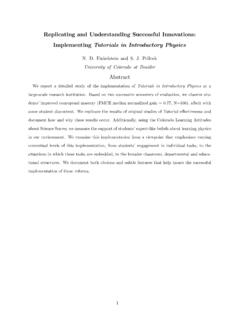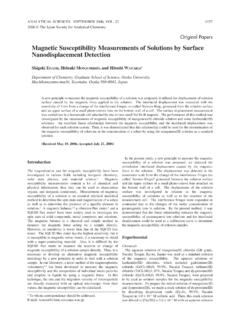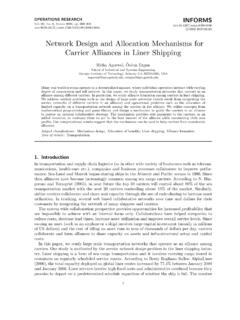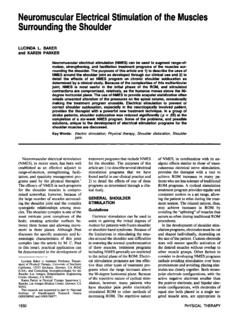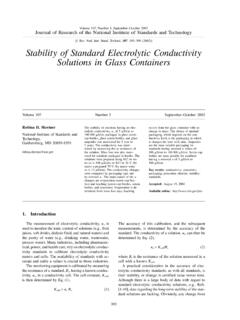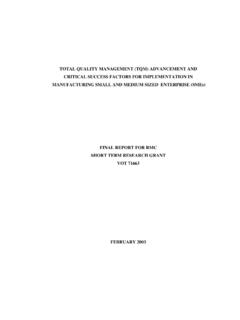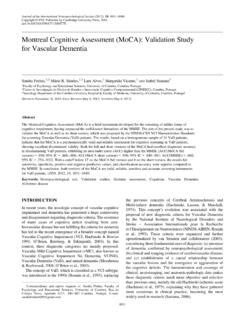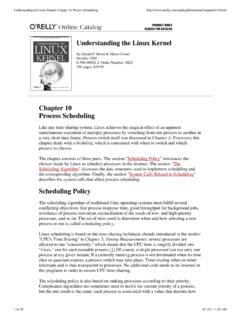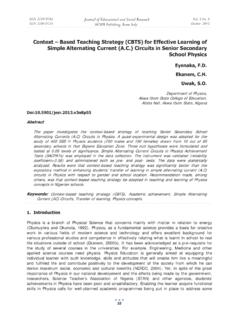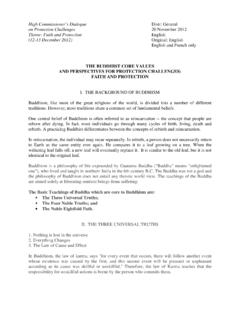Transcription of An overview of benchmarking benchmarking process: a tool ...
1 An overview ofbenchmarkingprocess229An overview of benchmarkingprocess: a tool for continuousimprovement and competitiveadvantageDean Elmuti and Yunus KathawalaLumpkin College of Business and Applied Sciences, Eastern IllinoisUniversity, Charleston, Illinois, USAI ntroductionThe essence of benchmarking is the process of identifying the higheststandards of excellence for products, services, or processes, and then makingthe improvements necessary to reach those standards, commonly called bestpractices . The justification lies partly in the question: Why re-invent thewheel if I can learn from someone who has already done it? Jackson GraysonJr, chairman of the Houston-based American Productivity and Quality Center,which offers training in benchmarking and consulting services, reports anincredible amount of interest in benchmarking (Ross, 1995, p. 235). benchmarking was begun in the late 1970s by Xerox Corporation. Duringthis time, Xerox was losing market share and feeling a lot of pressure from itscompetitors.
2 In an attempt to try and get back into the game , Xerox decidedto compare its operations to those of its competitors. After finding qualitystandards with which to compare itself, Xerox began one of the greatest trendsin the business world today (McNair and Leibfried, 1992). benchmarking has been gaining popularity, especially in the last five process of benchmarking is more than just a means of gathering data onhow well a company performs against others. benchmarking can be used in avariety of industries, both services and manufacturing. It is also a method ofidentifying new ideas and new ways of improving processes and, therefore,being better able to meet the expectations of customers. The ultimate objectiveof benchmarking is process improvement that meets the attributes of customerexpectations (Omachonu and Ross, 1994, pp. 140-1).Robert C. Camp headed up the now-famous study at Xerox in which thebuzzword benchmarking was coined in late 1980. When asked whether thebest work practices necessarily improve the bottom line, he replied: the fulldefinition of benchmarking is finding and implementing best practices in ourbusiness, practices that meet customer requirements.
3 So the flywheel on findingthe very best, is Does this meet customer requirements? There is a cost ofquality that exceeds customer requirements. The basic objective is satisfyingthe customer, so that is the limiter (Linsenmeyer, 1991, p. 34). benchmarking for QualityManagement & Technology,Vol. 4 No. 4, 1997, pp. 229-243 MCB University Press, 1351-3036 BQM&T4,4230 This article is an overview of benchmarking process and its implications forcontinuous improvement and competitive advantage . In addition, the perceivedbenefits, costs, and the process of implementation of benchmarking areexplored. The ethical and legal implications for the introduction andimplementation of benchmarking process are also and perceived benefits of benchmarkingBenchmarking is the process by which companies look at the best in theindustry and try to imitate their styles and processes. This helps companies todetermine what they could be doing better. The decision to begin benchmarkingis valuable to companies by opening up many different ideas to processes,approaches, and concerns (Allan, 1997).
4 Increasing productivity and individual designCompanies are benchmarking for a variety of reasons. The reasons can bebroad, such as increasing productivity, or they can be specific, such asimproving an individual design. By simply looking outside itself, a companycan identify breakthroughs in thinking. A similar process used in a differentway can shed light on new opportunities to use the original process (Muschter,1997). Strategic toolLeapfrogging competition is another reason to use benchmarking as a strategictool. A company s competitors may be stuck in the same rut as the companydeciding to benchmark. It would be possible to get a jump on competitors byusing new-found strategies. This opens up an opportunity for growth that thecompetitors may not be aware of ( , 2/19/97).Enhance learningAnother reason to benchmark is overcoming disbelief and enhancing example, selling or hearing about another company s processes and howthey are working will help employees to believe that there may be a better wayto compete (Brookhart, 1997).
5 Growth potentialBenchmarking may cause a necessary change in the culture of an a period of time in the industry, an organization may become too practisedat searching inside the company for growth. The company would be better offlooking outside its walls for potential areas of growth. An outward lookingcompany tends also to be a future oriented company. This often leads to a moreenhanced organization and increased profits ( , 2/19/97).An overview ofbenchmarkingprocess231 Assessment of performance toolBenchmarking is defined as the process of identifying and learning from bestpractices anywhere in the world (Allan, 1997). By identifying the best practices, organizations know where they stand in relation to other other companies can be used as evidence of problem areas, and providepossible solutions for each area. When companies benchmark, they usepartners to share information with and learn from each other. Benchmarkingallows organizations to understand their own administrative operations better,and marks target areas for improvement .
6 It is an ideal way to learn from othercompanies who are more successful in certain areas. Additionally, benchmarking can eliminate waste and help to improve a company s marketshare (Allan, 1997; , 2/19/97). continuous improvement toolBenchmarking is increasing in popularity as a tool for continuousimprovement. Organizations that faithfully use benchmarking strategiesachieve a cost savings of 30 to 40 per cent or more. benchmarking establishesmethods of measuring each area in terms of units of output as well as cost. Inaddition, benchmarking can support the process of budgeting, strategicplanning, and capital planning (Lyonnais, 1997).In the early 1980s, Ford Motor Company needed to change many aspects ofits operations to cut costs due to the suffering automotive market. Managementbelieved it could improve processes in the accounts payable department. Aftergathering data on Mazda s accounts payable operations, Ford analyzed andcompared its own accounts payable operations.
7 As a result, Ford reduced costsby 5 per cent ( , 2/19/97).Vehicle to improve performanceBenchmarking also allows companies to learn new and innovative approachesto issues facing management which, in turn, provides the basis for acts as vehicle to improve performance by assisting in settingachievable goals that have already been proven successful. It overcomesdisbelief that there are, by example, other ways of achieving and creatingoverall enhancement of an organization (Fuller, 1997).Types of benchmarkingThere are four different types of benchmarking which consist of: internalbenchmarking, competitive benchmarking , functional or industrybenchmarking, and process or generic benchmarking . Before deciding tobenchmark, a company needs to determine what it is they want to benchmark.(1) The first basic type of benchmarking is internal benchmarking . This isbenchmarking against operations. It is one of the simplest forms sincemost companies have similar functions inside their business the internal performance standards of an organization isBQM&T4,4232internal benchmarking s main objective.
8 This enables the sharing of amultitude of information. The benefit of immediate gain comes fromidentifying the best internal procedures and being able to transfer themto other portions of the organization. Unless it is later used as a baselinefor external benchmarking , companies implementing this type can oftenretain an introverted view (Matters and Evans, 1997).(2) competitive benchmarking is a type used with direct competitors. Doneexternally, competitive benchmarking s goal is to compare companies inthe same markets which have competing products, services, or workprocesses. An example would be McDonald s versus Burger King. Underthis type of strategy, it is advantageous to see what a company s relatedperformance is. Only under certain conditions with direct competitors,information would be easy to reach. Particularly information in thepublic domain would be the most accessible. Competitors may choose tomake it very difficult to obtain their priceless information (Finch andLuebbe, 1995).
9 (3) Functional or industry benchmarking is performed externally againstindustry leaders or the best functional operations of certain benchmarking partners are usually those who share some commontechnological and market characteristics. They also seem to concentrateon specific functions. Because there are no direct competitors involved,the benchmarking partner is more willing to contribute and share. Adisadvantage can be the cost and scheduling of the already overwhelmedbenchmarked companies (Matters and Evans, 1997).(4) Finally, process or generic benchmarking focuses on the best workprocesses. Instead of directing the benchmarking to the businesspractices of a company, the similar procedures and functions areemphasized. This type can be used across dissimilar it is thought to be extremely effective, it is difficult toimplement. Generic benchmarking requires a broad conceptualizing ofthe entire process and a careful understanding of the procedures (Finchand Luebbe, 1995; Matters and Evans, 1997).
10 Each company should evaluate carefully its own perspective in whatbenchmarking is and how they wish to use this process. The company needs todetermine whether their focus is on financial results or on meeting customerrequirements. This is the only effective way to begin the benchmarking benchmarking processBenchmarking is a very structured process that consists of several steps to betaken. These steps are often provided for in a model. It should be noted thateven though the process is very structured, it should not add complexity to asimple idea. Basically, the structure should not get in the way of the process .An overview ofbenchmarkingprocess233 Most models of benchmarking process include the following steps, according toBateman (1994) (see Figure 1).According to The Nuts and Bolts of benchmarking , written by MargaretMatters and Anne Evans (1997), there are five stages included in thebenchmarking process which are discussed below:(1) Planning the exercise: this step involves identifying the strategic intentof the business or process to be benchmarked.

